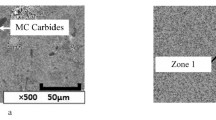Abstract
The reheat cracking susceptibility of the heat-affected zone (HAZ) of a CrMoV turbine rotor steel was investigated. Two base materials, one with a coarse-grain (155 µxm) and the other with a fine-grain (55 µim@#@) microstructure, were submitted to Gleeble HAZ weld simulations. Three peak temperatures were utilized: 1350,1150, and 950 °. Some samples were single cycled, and others were exposed to a double cycle. The samples that were double cycled experienced a second peak temperature 150 to 250 ° lower than the first peak temperature. The samples were then stressed in bending for different amounts and stress relieved under load to determine their reheat cracking susceptibility. All samples were metallurgically evaluated before and after the reheat cracking test. It was found that the prior-austenite grain size of the original base metal did not influence the reheat cracking susceptibility, but increases in peak temperature did. It was observed that the grain size and grain matrix microhardness that developed after the Gleeble cycles affected reheat cracking. It was found that reheat cracking did not occur when the microhardness was below 350 DPH and the prior-austenite grain size was less than about 80 µm.
Similar content being viewed by others
References
S.H. Bush, Failures in Large Steam Turbine Rotors,Proceedings: Rotor Forgingsfor Turbines and Generators, EPRI WS-79-235, Electric Power Research Institute, 1981, p 1–1 to 1–27
R.T. Hagaman, Failures Experience with Generator Rotors,Proceedings: Rotor Forgings for Turbines and Generators, EPRI WS-79-235, Electric Power Research Institute, 1981, p 1 –32 to 1–39
J. Byron, inProceedings: Weld Repair of High and Intermediate Pressure Steam Turbine Rotors for Life Extension, EPRI GS-6233, Electric Power Research Institute, 1989, p 5–6
S. Bayard, P.A. Coulon, and M. Nougaret, inProceedings: Weld Repair of High and Intermediate Pressure Steam Turbine Rotors for Life Extension, EPRI GS-6233, Electric Power Research Institute, 1989, p 2–15 to 2–27
R.E. Munson and N.D. Russell, inProceedings: Weld Repair of High and Intermediate Pressure Steam Turbine Rotors for Life Extension, EPRI GS-6233, Electric Power Research Institute, 1989, p 1-40 to 1-54
R.E. Clark, J.M. Schmerling, D.R. Amos, and L.D. Kramer, Experience with Weld Repair of Low Pressure Steam Turbine Rotors,Proceedings: American Power Conference, Illinois Institute of Technology, Chicago, IL, 1985.
V.N. Zemzin and R.Z. Shron,Avtom. Svarka, Vol 21 (No. 6), 1968, pl
N.T. Burguess,Weld. Met. Fabr., Vol 30, 1962, p 105
K.P. Bently,Br. Weld. J., Vol 11, 1964, p 507
G.S. Kim, J.E. Indacochea, and T.D. Spry, Metallurgical Aspects in Welding CrMoV Turbine Rotor Steels—Part 1: Evaluation of Base Material and Heat Affected Zone,J. Mater. Sci. Technol., Vol 7, 1991, p 42–49
G.S. Kim, J.E. Indacochea, and T.D. Spry, Metallurgical Aspects in Welding CrMoV Turbine Rotor Steels—Part 2: Evaluation of Narrow-Gap Submerged-Arc Weldment,J. Mater. Sci. Technol., Vol 7, 1991, p 147–154
Author information
Authors and Affiliations
Rights and permissions
About this article
Cite this article
Indacochea, J.E., Kim, G.S. Reheat cracking studies on simulated heat-affected zones of CrMoV turbine rotor steels. JMEP 5, 353–364 (1996). https://doi.org/10.1007/BF02649337
Issue Date:
DOI: https://doi.org/10.1007/BF02649337




